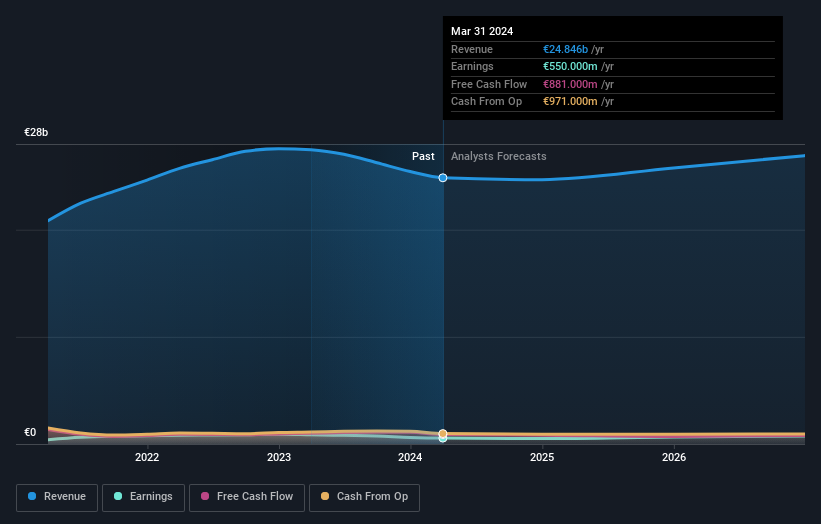- Netherlands
- /
- Professional Services
- /
- ENXTAM:RAND
Randstad N.V. (AMS:RAND) Just Released Its First-Quarter Results And Analysts Are Updating Their Estimates

Shareholders might have noticed that Randstad N.V. (AMS:RAND) filed its quarterly result this time last week. The early response was not positive, with shares down 5.5% to €45.69 in the past week. Revenues of €5.9b were in line with forecasts, although statutory earnings per share (EPS) came in below expectations at €0.48, missing estimates by 3.3%. The analysts typically update their forecasts at each earnings report, and we can judge from their estimates whether their view of the company has changed or if there are any new concerns to be aware of. We thought readers would find it interesting to see the analysts latest (statutory) post-earnings forecasts for next year.
View our latest analysis for Randstad

Following last week's earnings report, Randstad's 13 analysts are forecasting 2024 revenues to be €24.7b, approximately in line with the last 12 months. Statutory earnings per share are forecast to dip 8.5% to €2.84 in the same period. In the lead-up to this report, the analysts had been modelling revenues of €25.3b and earnings per share (EPS) of €3.01 in 2024. It's pretty clear that pessimism has reared its head after the latest results, leading to a weaker revenue outlook and a small dip in earnings per share estimates.
Despite the cuts to forecast earnings, there was no real change to the €50.63 price target, showing that the analysts don't think the changes have a meaningful impact on its intrinsic value. That's not the only conclusion we can draw from this data however, as some investors also like to consider the spread in estimates when evaluating analyst price targets. There are some variant perceptions on Randstad, with the most bullish analyst valuing it at €80.00 and the most bearish at €41.00 per share. This is a fairly broad spread of estimates, suggesting that analysts are forecasting a wide range of possible outcomes for the business.
Of course, another way to look at these forecasts is to place them into context against the industry itself. We would highlight that revenue is expected to reverse, with a forecast 0.9% annualised decline to the end of 2024. That is a notable change from historical growth of 3.7% over the last five years. By contrast, our data suggests that other companies (with analyst coverage) in the same industry are forecast to see their revenue grow 4.9% annually for the foreseeable future. So although its revenues are forecast to shrink, this cloud does not come with a silver lining - Randstad is expected to lag the wider industry.
The Bottom Line
The biggest concern is that the analysts reduced their earnings per share estimates, suggesting business headwinds could lay ahead for Randstad. Unfortunately, they also downgraded their revenue estimates, and our data indicates underperformance compared to the wider industry. Even so, earnings per share are more important to the intrinsic value of the business. The consensus price target held steady at €50.63, with the latest estimates not enough to have an impact on their price targets.
Following on from that line of thought, we think that the long-term prospects of the business are much more relevant than next year's earnings. We have estimates - from multiple Randstad analysts - going out to 2026, and you can see them free on our platform here.
However, before you get too enthused, we've discovered 2 warning signs for Randstad that you should be aware of.
New: AI Stock Screener & Alerts
Our new AI Stock Screener scans the market every day to uncover opportunities.
• Dividend Powerhouses (3%+ Yield)
• Undervalued Small Caps with Insider Buying
• High growth Tech and AI Companies
Or build your own from over 50 metrics.
Have feedback on this article? Concerned about the content? Get in touch with us directly. Alternatively, email editorial-team (at) simplywallst.com.
This article by Simply Wall St is general in nature. We provide commentary based on historical data and analyst forecasts only using an unbiased methodology and our articles are not intended to be financial advice. It does not constitute a recommendation to buy or sell any stock, and does not take account of your objectives, or your financial situation. We aim to bring you long-term focused analysis driven by fundamental data. Note that our analysis may not factor in the latest price-sensitive company announcements or qualitative material. Simply Wall St has no position in any stocks mentioned.
About ENXTAM:RAND
Randstad
Provides solutions in the field of work and human resources services primarily in North America, Northern Europe, Southern Europe, the United Kingdom, Latin America, and the Asia Pacific.
Excellent balance sheet with moderate growth potential.
Similar Companies
Market Insights
Community Narratives




